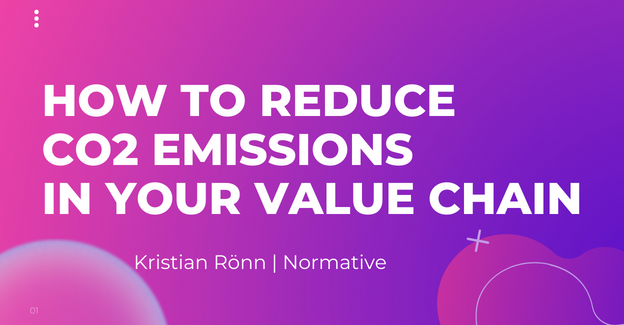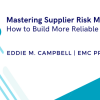"The majority of a company's carbon emissions occur in its value chain. By engaging your suppliers in carbon reduction, you can contribute to the fight against climate change while keeping your businesses competitive and legally compliant,” says Kristian Rönn, Co-Founder and CEO of Normative. Kristian shares deep insight into working closely with your value chain and three main approaches to engaging suppliers.
Climate change will not wait, and companies need to enact immediate and drastic emission reductions if we are to meet global climate targets. If your company is like most others, most of your emissions will originate in your value chain, including both the upstream emissions from your supply chain and the downstream emissions from product use and disposal.
Because they don’t originate directly from your company’s activities, these emissions are tricky to measure and even trickier to reduce. However, according to the CDP, it’s vital to do so as these value chain emissions account for an average of around 90% of a business’ total carbon footprint.
So, if your company is looking to reduce its climate impact, logic says you should begin by making high-impact changes in your supply chain. Add in that reducing emissions could also result in substantial cost reductions and efficiency gains, plus earning the trust of investors and employees, and you’ll likely want to get started as soon as possible.
Reduction Begins With Measurement
The first step toward reduction is to measure these value chain emissions fully. The most time-efficient way to achieve comprehensive and accurate emissions measurements is to use a carbon accounting platform.
Once you have measured your emissions and identified your hotspots, devise a strategy for engagement and prioritization. Value chain engagement can take many forms: engaging your suppliers, switching to low-carbon financial investments, decarbonizing your product and service design, or implementing circular economy principles.
For many companies, suppliers account for a large share of value chain emissions. So, in the following section, we’ll explore methods businesses can use to engage their suppliers and reduce their value chain emissions.
Engaging Your Suppliers
Supplier engagement is a key mechanism to affect impactful emissions reduction — and those who work in procurement and sourcing are perfectly placed to begin this supplier engagement. At Normative, we recommend three main approaches to engaging suppliers, with varying levels of complexity:
Informative Approach
Summary: Sharing best practices and materials on addressing emission reduction
Level of Complexity: Medium to Low. Medium involvement for the company. Suitable for all companies.
Passive Enforcing Approach
Summary: Updating internal procurement guidelines to prioritize suppliers that comply with sustainability criteria
Level of Complexity: High. High level of involvement for the company. Suitable for larger, high-revenue companies.
Active Enforcing Approach
Summary: Updating supplier Code of Conduct to make it mandatory for suppliers to disclose their emissions. Obligatory reduction targets.
Level of Complexity: High. High level of involvement for the company. Suitable for larger, high-revenue companies.
Good communication is a crucial part of successful supplier engagement. Explaining why climate performance insights are important to you helps to build trust and identify opportunities for collaboration and support.
Some of your suppliers may already be making good progress toward emission reduction, whereas others may not know where to start. Ask suppliers whether they are tracking emissions and following reduction targets. Make sure to communicate to suppliers what’s in it for them:
- Contributing to the fight against climate change
- Staying ahead of upcoming regulation
- It’s good business — they’ll gain competitive advantages and unlock funding
For suppliers still in the early stages and lacking know-how, consider running information-sharing sessions such as webinars. Point suppliers toward third-party services that can help them get started.
There are many ways of encouraging suppliers to track and reduce emissions. For example, you can have a supplier recognition program. Additionally, within your procurement team, you can prioritize low-emission suppliers or impose specific sustainability requirements on suppliers.
At Normative, we work with companies to reduce their carbon footprints, with a special emphasis on value chain emissions. In our work, we see that many companies want to act but don’t know where to start. The good news is that a little bit of strategic focus and target-setting goes a long way — jump-starting your emissions reduction journey and bringing in new business opportunities.
Find more about engaging your value chain to reduce carbon emissions in Reducing value chain carbon emissions: a practical guide at Normative.io
Region:









